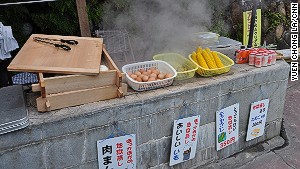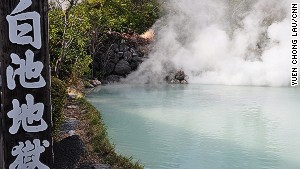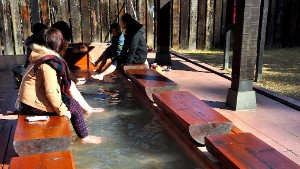February 3, 2014 -- Updated 0403 GMT (1203 HKT)
STORY HIGHLIGHTS
- Beppu is home to more than 2,500 onsen, or hot springs
- Water in the "Eight Hells" springs can reach 150 C
- "Demon Mountain Hell" is home to crocodiles and alligators
(CNN) -- "The heat gets pretty unbearable in Beppu during the summer, with all the hot springs," says Sachiko Okuda, a veteran tour guide and native of Japan's "hot spring capital."
Looking out the bus window on the way into town, it's easy to believe her.
Steam spews from every other building.
Beppu, in central Oita prefecture, is home to more than 2,500 onsen -- hot springs.
It's the world's second largest source of thermal spring water after Yellowstone National Park in the United States.
"During Golden Week, we get around 60,000 visitors staying at our onsen resorts," Okuda explains.
But we're not hot-tubbing today.
We're on our way to Beppu's so-called Eight Hells (jigoku) hot springs, where the water gushes out at temperatures as hot as 150 C.
Some also spout vermillion colored steam -- each "hell" is different in its own intense way.
Umi-Jigoku (Sea Hell)
About 1,200 years ago, a volcano erupted and the cobalt-blue Umi-Jigoku sprang forth -- iron sulfate being the source of its lovely color.
Don't be lulled by its beauty, though -- the hot spring is 200 meters deep and, at 98 C, almost boiling.
The steam heats a nearby greenhouse where Victoria amazonica water lilies bloom between May and November.
Right by the entrance, stores sell pudding cooked in the hot spring's steam.
Oniishibozu-Jigoku (Oniishi Shaven Head Hell)
Even hotter than Umi-Jigoku, at an average 99 C, Oniishibozu-Jigoku gets its name from the gray mud bubbles it spouts that are said to resemble a monk's shaven head.
The town Onishi (one "i"), in Gunma prefecture, signals its hellish association by using the kanji character for "demon" in its name.
Every February, the people of Onishi clear their homes of evil spirits by throwing soybeans at invisible demons during the Onishi Setsubun festival.
Yama-Jigoku (Mountain Hell)
Resembling mountains of mud according to legend, the pools of Yama-Jigoku are in reality more like steaming puddles.
Harmless though they might appear, they reache a scorching 90 C.
A mini zoo nearby features animals acclimated to the heat -- flamingos, monkeys, snakes and a hippopotamus who waits to be fed carrots.
It wouldn't be "Cooking Pot Hell" without steamed vegetables and hard-boiled eggs.
Kamado-Jigoku (Cooking Pot Hell)
A red demon statue atop a cooking pot guards the entrance to Kamado-Jigoku. Some of the six differently colored ponds here reach boiling point.
There are -- less hot -- hand and foot baths, drinking water at 80 C and jigoku-mushi: Vegetables and hard-boiled eggs cooked in the boiling water and steam.
Oniyama-Jigoku (Demon Mountain Hell)
Also known as "Crocodile Hell," Oniyama is home to around 80 of the creatures, as well as alligators slithering around in murky water pouring in from a salt spring.
The steam pressure here is strong enough to pull one and a half train carriages, as well as creating ideal crocodile-breeding conditions, an onsite sign discloses.
White Pond Hell's color comes from a combo of boric acid, salt, sodium silicate and calcium bicarbonate.
Shiraike-Jigoku (White Pond Hell)
With rocks in the middle of a milky green pond and its surrounding bushes, Shiraike resembles a Japanese zen garden.
A hot spring spouts creamy white steam at 95 C.
The water's milky color comes from a mixture of boric acid, salt, sodium silicate and calcium bicarbonate.
Piranhas are among the fish kept in a run-down aquarium nearby.
Tatsumaki-Jigoku (Tornado Hell)
Regarded as a natural treasure of Beppu, Tatsumaki is one of Japan's few geysers.
Erupting every half an hour or so for up to 10 minutes, its spout can reach 50 meters without the stone plate that is used to block it off.
At a fiendish 150 C, Tatsumaki also has the hottest water of all the hells and emits hot sulfurous gases.
Away from the "Blood Pond," visitors can warm up their toes in less extreme hot spring waters.
Chinoike-Jigoku (Blood Pond Hell)
Not only is the water red here, but the steam too.
The oldest of the hells, Chinoike's vermillion color comes from the acidic iron and magnesium-filled clay oozing from the ground.
At 78 C, this is also the coolest of the eight hells, but signage reminds visitors that you still can't take a dip.
An ointment made from the clay that's used to treat skin diseases is sold at a stand nearby.
Getting there
Beppu is a two-hour train ride from Fukuoka's Hakata station on the limited express Sonic train.
From JR Beppu station, take a 15-minute ride on Kamei bus 5, 7 or 9 to reach Kannawa bus terminal, where the first six hells are located.
From Kannawa, a five-minute ride on Kamei bus 16 or 16A takes you to Chinoike-Jigoku and Tatsumaki-Jigoku in Shibaseki hells. The same buses also return you to Beppu station, a 40-minute journey.
Alternatively, Kamenoi bus company provides 2.5-hour tours (in Japanese) of all eight hells for ¥3,600 ($35).
Tours depart three times a day and can be booked the same day at the Beppu Foreign Tourist Information Office inside JR Beppu station.


 Kamado-Jigoku features six boiling ponds, ranging in color and temperatures, with some hitting 100 C.
Kamado-Jigoku features six boiling ponds, ranging in color and temperatures, with some hitting 100 C.


No comments:
Post a Comment